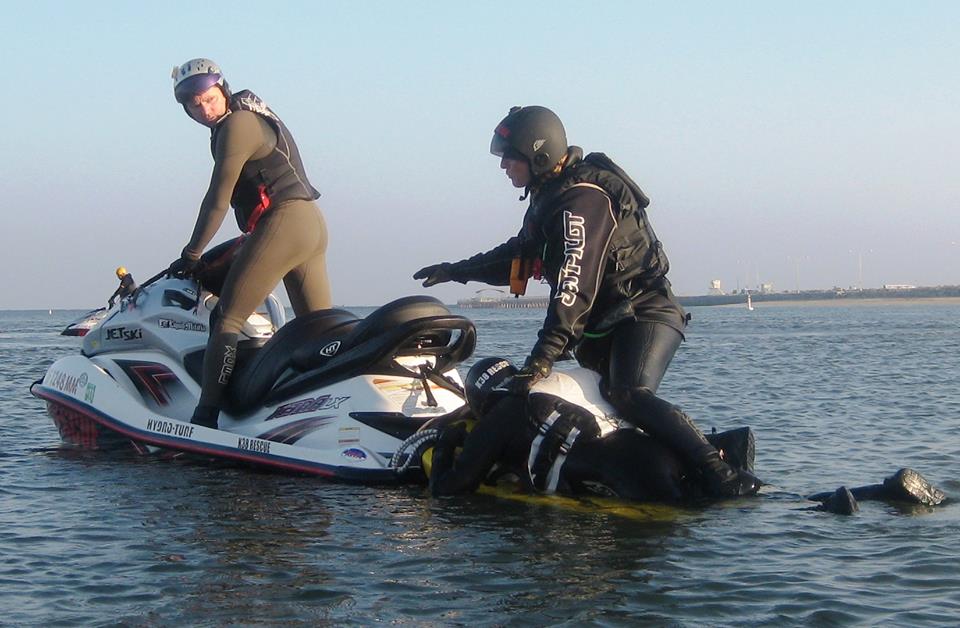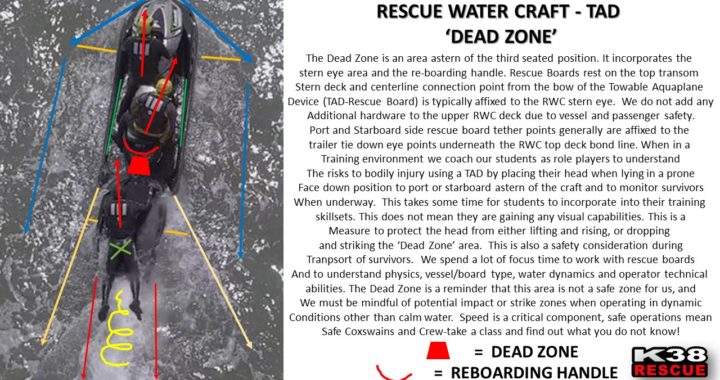Rescue Water Craft Dead Zone
The 'Dead Zone' is an area astern of the third seated position of the Rescue Water Craft (RWC). It incorporates the stern eye area, stern deck and the re-boarding handle and is referred to when using a TAD.
This area is one to observe for safety due to the range of motion between the Rescue Water Craft and the Towable Aquaplane Device (TAD-Rescue Board). This area is a location that we are aware of regarding a variety of movements and therefore have termed it the 'dead zone', meaning this is an area we try not to make physical contact with our hands and are mindful of body placement. It is a 'no go' area.
We utilize a developmental attitude of behavior regarding body placement on a TAD and try our best to minimize contact areas and hazards with a concerted awareness of possible strike zones, both from using a TAD and on board the RWC.
Be aware that not all operational situations will be possible to maintain efficiency in body placement or range of motion. These are best determined by the Coxswain training level, instructional content and familiarity with weather, vessel, TAD and not limited to being able to define the forces of action and range of motion and the objectives of training.
This requires of Coxswains and Crew members to have professional understanding and behavioral training regarding this risk area.
Items to consider during training with a TAD:
1. Type of RWC and TAD
2. Conditions of water and weather
3. Communications between Coxswain/Crew and training goals
4. Review, correction and counseling of supervisor and/or Coxswain/crew operations
5. Speed of the craft and turning radius applied with associated weight distribution on the TAD
6. TAD connectivity
It is impossible to cover everything we would normally prescribe in our training program for student candidates. We can give you some ideas to ponder and size up against common sense and water safety. Let's dig in!
Rescue Boards rest on the top transom stern deck and centerline connection point from the bow of the Towable Aquaplane
Device (TAD-Rescue Board) is typically affixed to the RWC stern eye.
We do not add any additional hardware to the upper RWC deck due to vessel and passenger safety. We would not advise
agencies or personnel to drill holes through the RWC hull and add additional bow eyes to the top deck. Especially if
working in flood environments or drawing bodies over these areas.
These could become strike points, facial contact, create entanglement or entrapment, wrap long hair (scalping) or garments and cause breaks/fractures/amputations of fingers if rings are worn.
Port and Starboard side rescue board tether points generally are affixed to the trailer tie down eye points underneath the RWC top deck bond line. The trailer tie down eyes are actually a very strong tow point, but rarely is there direct load on these two points. Generally there is a giveway or slack and shock effect depending upon the style of board, the interface of connectivity and the amount of weight pushing downward with gravitational force.
Rescue boards are not floating per se, they are dragging, pivoting, rising and lowering. They are a towable aquaplane device that rests semi forward on the stern deck of a Rescue Water Craft.
There is a pitch upward and downward at the fulcrum point of interface between the rescue board bottom deck. There is also interface of the bow tether point that can crease the topside of the rescue board if too much force is applied or if pinned against a fixed object or rolled such as in waves. Always touch check and visibly inspect your rescue board and retire when needed.
When in a training environment we coach our students as role players to understand the risks to bodily injury using a TAD such as placing their head when lying in a prone face down position to port or starboard astern of the craft and to monitor survivors body positioning or changing positions while underway.
When underway in the same fashion changes of body position will occur with the interface between water movement and Coxswain helms control and trim. There is not a lot of deck space however we have studied the most practical methods by observing RWC, board, water and human movements and have determined that the 'dead zone' is a clear reminder for personal safety.
It's easy to say and clear to remember. This is a non-operative area. No hands should be in this area between the board and the boat, these are pinch points due to the lifting up and downward motions between the two leverage points.
This takes some time for students to incorporate into their training skillsets, this does not happen as a behavior during their first rotation. It takes many reminders and self assessment to correct and enable the safety behaviors. These corrections can be mere inches and change while underway due to vessel movement or body positioning.
It is important to consider anchor points, handheld points, foot wedges (not entrapment) and the pivot or sway of the rescue board. This does not mean they are gaining any visual capabilities. This is a measure to protect the head from either lifting and rising, or dropping and striking the ‘Dead Zone’ area in case of mishap.
There are a lot of contributing factors. Video review of incorrect and correct methods may assist you in understanding the risks and determining what would be the best course of action with the make and model of RWC and board. This is a difficult discussion to harness without proper coaching, so do not use all of this as a set in stone way of operating. There are many contributing actions that apply, such as operator and crew knowledge, Rescue Board inspection, RWC inspection and a firm understanding of the waterway you will be training and working under. And then, add pressure of a real life situation.
This is also a safety consideration during transport of survivors. Another rule we would like you to consider along with the 'dead zone' is a safe speed transport set at about 25 miles per hour. There are many technical needs, so don't fixate on just one, we teach hundreds of variations that enable the operators to select their underway options.
Don't forget that wise saying 'where the head goes the body follows'.

Use Common Sense, Evaluate, Study, Learn and Correct
REVIEW YOUR PROGRAM USE
Let's recap:
1. Do not add hardware to the RWC top deck where bodies come in contact
2. Observe the Dead Zone area astern and be mindful of points of contact
3. Safe Speeds Underway (25 mph rule), crew communicates with Coxswain is speed is determined unsafe
4. Coxswains maintain a level, steady and stable RWC at all times, Crew maintains the efficiency use of survivor loading and
underway security and secures the final stop measures
5. Observe counterbalance measures between the RWC and TAD and Persons on Board (POB).
We spend a lot of focus time to work with rescue boards to gain understanding in simple physics, vessel/board type, water dynamics and operator technical abilities. We want our Coxswains and Crew to be 100% responsible for their underway actions. We believe this is possible with a strong mindset, knowledge base and policies that work for success of the mission.
The Dead Zone is a reminder that this area is not a safe zone for us, to respect our board and rescue board use, and we must be mindful of potential impact or strike zones when operating in dynamic conditions other than calm water.
Speed is a critical component of professional marine units, safe operations mean Safe Coxswains and Crew who maintain a safe and successful program!
There are typically three ways of operations for crew to consider and train under until familiarization occurs:
1. Laying prone face down on a TAD
2. Layering weight and body positions on a TAD (multiple persons on board)
3. Kneeling-bracing position on TAD as Crew
4. Sitting position on RWC stern seat
Please consider taking a class and find out what you do not know!
It's far less expensive than the long rough road of mishap review and repair.
We hope to see you in a class!
Posted: 10.27.2018
Have any questions? Join the Rescue Water Craft Association
and discover what your community is doing to modernize standards, safety and reduce liability!
Join the Rescue Water Craft Association
Content Creator: Shawn Alladio cares most about her community and the culture surrounding the safety of event service providers and Rescue Water Craft operators, working hard and dedicated towards protecting their reputation, distributing safety information and continuing to train these amazing individuals to the highest standards of care.
Use at your own risk. Please take a qualified Rescue Water Craft training course and maintain proper records and respect all the PWC, RWC, PPE, and gear OEM manufacturer warning labels and cautions.
